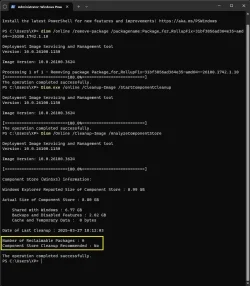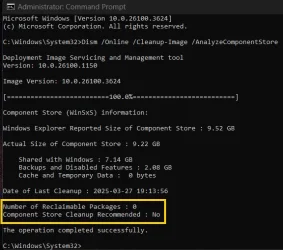In 24H2 the command
But they remain there after the cleanup command
They are even present in a clean install.

I am grateful to @hader who showed how to identify the offending packages.
I have found that if I uninstall just the Package_for_RollupFix~31bf3856ad364e35~amd64~~26100.1742.1.10 package, in doing so the Microsoft-Windows-FodMetadataServicing-Desktop-Metadata-Package~31bf3856ad364e35~amd64~~10.0.26100.1742 package gets removed at the same time.

How to identify Reclaimable Packages reported as count by "Dism /Online /CleanUp-Image /AnalyzeComponentStore" - post#59
A new cumulative update, KB5053656, gave me the opportunity to test that removing the packages did not interfere with further updates, and that the two (un)reclaimable packages did not return.

KB5053656 Windows 11 Cumulative Update Preview build 26100.3624 (24H2) - March 27 - post #22
These packages date back to build 26100.1742, the initial release of 24H2. They have long been superseded, removing them should do no harm, and means that DISM now reports correctly whether or not a cleanup is recommended.
Dism /Online /Cleanup-Image /AnalyzeComponentStore always shows that there are 2 reclaimable packages, and that a cleanup is recommended.But they remain there after the cleanup command
Dism /Online /Cleanup-Image /StartComponentCleanupThey are even present in a clean install.
As an experiment I did a clean install with a 26100.2033 USB made by the MCT. At no point did I let it connect to the internet. These two unreclaimable packages were already present. There is no possible way to avoid them, the fault is built into the install media!
I am grateful to @hader who showed how to identify the offending packages.
2 Packages are responsible for that;
- [Microsoft-Windows-FodMetadataServicing-Desktop-Metadata-Package~31bf3856ad364e35~amd64~~10.0.26100.1742]
- [Package_for_RollupFix~31bf3856ad364e35~amd64~~26100.1742.1.10]
Both packages "is a top-level package and is deeply superseded".....
This info can be seen inside the C:\Windows\Logs\CBS\CBS.log file after a dism /online /cleanup-image /AnalyzeComponentStore command.
I have found that if I uninstall just the Package_for_RollupFix~31bf3856ad364e35~amd64~~26100.1742.1.10 package, in doing so the Microsoft-Windows-FodMetadataServicing-Desktop-Metadata-Package~31bf3856ad364e35~amd64~~10.0.26100.1742 package gets removed at the same time.
This one command removes both....
dism /online /remove-package /packagename:Package_for_RollupFix~31bf3856ad364e35~amd64~~26100.1742.1.10
How to identify Reclaimable Packages reported as count by "Dism /Online /CleanUp-Image /AnalyzeComponentStore" - post#59
A new cumulative update, KB5053656, gave me the opportunity to test that removing the packages did not interfere with further updates, and that the two (un)reclaimable packages did not return.
KB5053656 Windows 11 Cumulative Update Preview build 26100.3624 (24H2) - March 27 - post #22
These packages date back to build 26100.1742, the initial release of 24H2. They have long been superseded, removing them should do no harm, and means that DISM now reports correctly whether or not a cleanup is recommended.
Last edited:
My Computers
System One System Two
-
- OS
- Windows 11 Home
- Computer type
- Laptop
- Manufacturer/Model
- Acer Aspire 3 A315-23
- CPU
- AMD Athlon Silver 3050U
- Memory
- 8GB
- Graphics Card(s)
- Radeon Graphics
- Monitor(s) Displays
- laptop screen
- Screen Resolution
- 1366x768 native resolution, up to 2560x1440 with Radeon Virtual Super Resolution
- Hard Drives
- 1TB Samsung EVO 870 SSD
- Internet Speed
- 50 Mbps
- Browser
- Edge, Firefox
- Antivirus
- Defender
- Other Info
- fully 'Windows 11 ready' laptop. Windows 10 C: partition migrated from my old unsupported 'main machine' then upgraded to 11. A test migration ran Insider builds for 2 months. When 11 was released on 5th October 2021 it was re-imaged back to 10 and was offered the upgrade in Windows Update on 20th October. Windows Update offered the 22H2 Feature Update on 20th September 2022. It got the 23H2 Feature Update on 4th November 2023 through Windows Update, and 24H2 on 3rd October 2024 through Windows Update by setting the Target Release Version for 24H2.
My SYSTEM THREE is a Dell Latitude 5410, i7-10610U, 32GB RAM, 512GB NVMe ssd, supported device running Windows 11 Pro.
My SYSTEM FOUR is a 2-in-1 convertible Lenovo Yoga 11e 20DA, Celeron N2930, 8GB RAM, 256GB ssd. Unsupported device: currently running Win10 Pro, plus Win11 Pro RTM and Insider Dev, Beta, and RP 24H2 as native boot vhdx.
My SYSTEM FIVE is a Dell Latitude 3190 2-in-1, Pentium Silver N5030, 8GB RAM, 512GB NVMe ssd, supported device running Windows 11 Pro, plus Insider Beta, Dev, and Canary builds (and a few others) as a native boot .vhdx.
My SYSTEM SIX is a Dell Latitude 5550, Core Ultra 7 165H, 64GB RAM, 1TB NVMe SSD, supported device, Windows 11 Pro 24H2, Hyper-V host machine.
-
- Operating System
- Windows 11 Pro
- Computer type
- Laptop
- Manufacturer/Model
- Dell Latitude E4310
- CPU
- Intel® Core™ i5-520M
- Motherboard
- 0T6M8G
- Memory
- 8GB
- Graphics card(s)
- (integrated graphics) Intel HD Graphics
- Screen Resolution
- 1366x768
- Hard Drives
- 500GB Crucial MX500 SSD
- Browser
- Firefox, Edge
- Antivirus
- Defender
- Other Info
- unsupported machine: Legacy bios, MBR, TPM 1.2, upgraded from W10 to W11 using W10/W11 hybrid install media workaround. In-place upgrade to 22H2 using ISO and a workaround. Feature Update to 23H2 by manually installing the Enablement Package. In-place upgrade to 24H2 using hybrid 23H2/24H2 install media. Also running Insider Beta, Dev, and Canary builds as a native boot .vhdx.
My SYSTEM THREE is a Dell Latitude 5410, i7-10610U, 32GB RAM, 512GB NVMe ssd, supported device running Windows 11 Pro.
My SYSTEM FOUR is a 2-in-1 convertible Lenovo Yoga 11e 20DA, Celeron N2930, 8GB RAM, 256GB ssd. Unsupported device: currently running Win10 Pro, plus Win11 Pro RTM and Insider Dev, Beta, and RP 24H2 as native boot vhdx.
My SYSTEM FIVE is a Dell Latitude 3190 2-in-1, Pentium Silver N5030, 8GB RAM, 512GB NVMe ssd, supported device running Windows 11 Pro, plus Insider Beta, Dev, and Canary builds (and a few others) as a native boot .vhdx.
My SYSTEM SIX is a Dell Latitude 5550, Core Ultra 7 165H, 64GB RAM, 1TB NVMe SSD, supported device, Windows 11 Pro 24H2, Hyper-V host machine.








